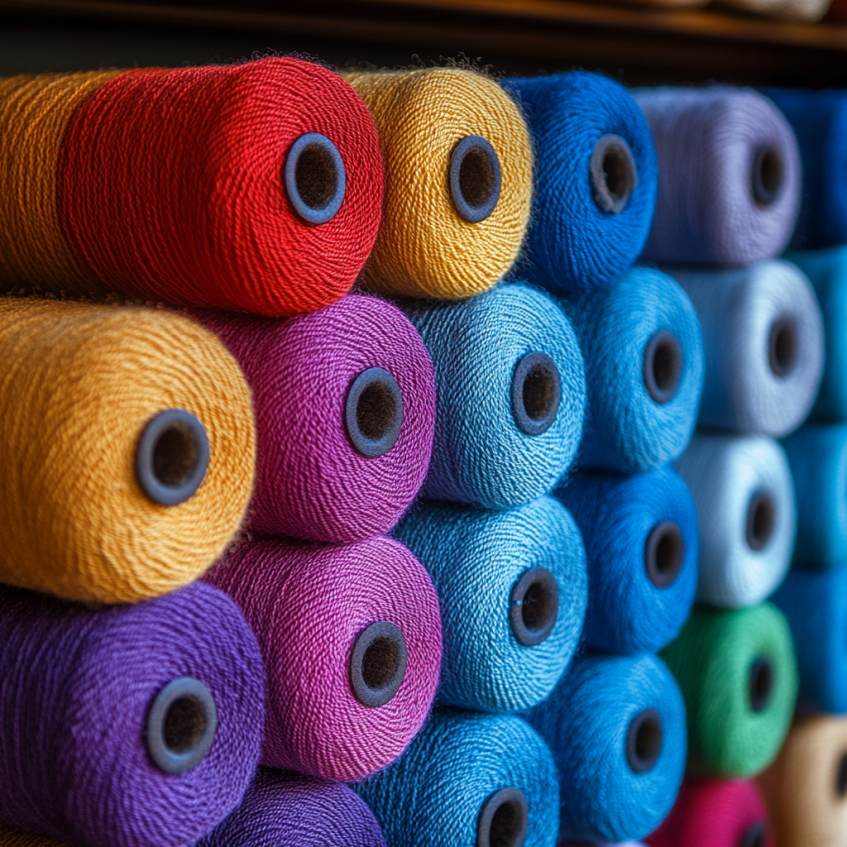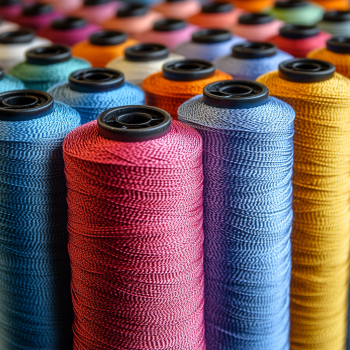Polyester yarn is a staple in the textile world, but how does it stack up against other synthetic yarns like nylon, acrylic, or polypropylene? If you’re a designer, manufacturer, or just curious about fabrics, understanding these differences can help you pick the right material for your project. This guide breaks down polyester yarn—its characteristics, applications, and how it compares to other synthetics—while offering fresh insights and practical tips.
Polyester yarn, derived from polyethylene terephthalate (PET), is a synthetic fiber spun into continuous filaments or staple fibers. It’s known for its durability, versatility, and cost-effectiveness, making it a go-to for everything from clothing to industrial textiles. Unlike natural fibers like cotton or wool, polyester yarn is engineered for specific performance traits, such as resistance to wear and vibrant dyeability.
Polyester yarn’s molecular structure, with tightly packed polymer chains, gives it superior strength (4.5-7.0 g/denier) compared to many natural fibers, making it a favorite for high-wear applications like upholstery.

Here’s what makes polyester yarn stand out, based on data from Neolianda.com:
Property | Description |
|---|---|
Strength | Tensile strength of 4.5-7.0 g/denier, ideal for durable textiles. |
Durability | Resists abrasion, stretching, and shrinking (shrinkage rate ~1-2%). |
Moisture Resistance | Low water absorption (0.4%), quick-drying, and mildew-resistant. |
Dyeability | Excellent color retention, supporting vibrant and fade-resistant dyes. |
Cost | Affordable, with production costs 20-30% lower than nylon in many cases. |
Recyclability | Often made from recycled PET, aligning with sustainable textile trends. |
To understand polyester yarn’s place in the synthetic family, let’s compare it to nylon, acrylic, and polypropylene—three common alternatives. Each has unique strengths, but polyester often strikes a balance of performance and affordability.
Feature | Polyester Yarn | Nylon Yarn | Acrylic Yarn | Polypropylene Yarn |
|---|---|---|---|---|
Strength | High (4.5-7.0 g/denier) | Very high (6.0-8.5 g/denier) | Moderate (2.5-4.0 g/denier) | Moderate (3.0-5.0 g/denier) |
Elasticity | Low (~40% elongation) | High (~20-40% stretch) | Moderate (~25-30% stretch) | Low (~15-25% stretch) |
Moisture Resistance | Excellent (0.4% absorption) | Good (4-5% absorption) | Poor (1-2% absorption, slow-drying) | Excellent (near 0% absorption) |
Heat Resistance | Moderate (melts at ~260°C) | Good (melts at ~250°C) | Poor (softens at ~220°C) | Low (melts at ~165°C) |
Cost | Low ($1-2/kg, per Neolianda.com) | Higher ($2-3/kg) | Moderate ($1.5-2.5/kg) | Very low ($0.8-1.5/kg) |
Common Uses | Apparel, upholstery, ropes | Sportswear, parachutes, nets | Sweaters, blankets, faux fur | Carpets, ropes, geotextiles |
Polyester yarn’s low cost and excellent dyeability make it a top pick for mass-produced textiles like T-shirts and curtains, while nylon’s superior elasticity suits high-stretch applications like activewear.

Polyester yarn’s versatility makes it a star in various industries. Here are its key applications, informed by Neolianda.com’s industry insights:
Apparel: Used in T-shirts, dresses, and jackets, often blended with cotton for breathability (e.g., 60% polyester/40% cotton blends).
Home Textiles: Curtains, bed sheets, and upholstery benefit from polyester’s durability and low shrinkage (1-2% vs. cotton’s 5-10%).
Industrial Uses: Ropes, conveyor belts, and sewing threads leverage polyester’s high tensile strength.
Sustainable Textiles: Recycled polyester yarn, made from PET bottles, is gaining traction in eco-friendly fashion and home goods.
Recycled polyester yarn, which accounts for ~14% of global polyester production (per Neolianda.com), reduces plastic waste and appeals to brands targeting eco-conscious consumers.
Polyester yarn is low-maintenance, but proper care keeps it looking sharp. Here’s how to maintain it:
Washing: Machine-wash at 30-40°C with mild detergent. Avoid bleach to preserve fiber strength.
Drying: Tumble dry on low or air-dry. Polyester’s low moisture absorption (0.4%) ensures quick drying.
Ironing: Use a low heat setting if needed; polyester’s wrinkle resistance often skips this step.
Storage: Store in a dry place to prevent mildew, though polyester’s mildew resistance is a big plus.
Polyester yarn’s quick-drying nature (dries 50% faster than cotton, per Neolianda.com) makes it ideal for busy households or outdoor gear, reducing energy costs for drying.
Material | Washing Temp | Drying Time | Ironing | Wrinkle Resistance |
|---|---|---|---|---|
Polyester Yarn | 30-40°C | Fast (~1 hr) | Low heat, if needed | High |
Nylon Yarn | 40-60°C | Moderate (~1.5 hr) | Low heat | Moderate |
Acrylic Yarn | 30°C, gentle | Slow (~2 hr) | Avoid, use steam | Moderate |
Cotton (Natural) | Up to 60°C | Slow (~2-3 hr) | High heat | Low |

To boost SEO and engage readers, here are content ideas based on search intent (informational, commercial, navigational):
Sustainability Trends: Highlight how recycled polyester yarn reduces landfill waste (e.g., 1 kg of recycled polyester saves ~50 PET bottles, per Neolianda.com).
Blending Benefits: Discuss polyester-cotton or polyester-wool blends for enhanced comfort and durability, appealing to designers.
DIY Projects: Suggest using polyester yarn for home crafts like macramé or sewing, targeting hobbyists.
Technical Specs: Explain denier ranges (e.g., 75D for apparel, 300D for ropes) to help manufacturers select the right yarn.
Searchers often seek both technical and practical info. Combining specs with DIY ideas can make your article a go-to resource for professionals and crafters.
Polyester yarn’s blend of strength, affordability, and versatility makes it a textile titan. It’s durable enough for industrial ropes, soft enough for cozy blankets, and eco-friendly when recycled. Compared to nylon’s stretch, acrylic’s softness, or polypropylene’s low cost, polyester offers a balanced middle ground. Whether you’re designing a budget-friendly clothing line or a heavy-duty industrial product, polyester yarn delivers.
Polyester yarn is a versatile, durable, and budget-friendly choice that holds its own against other synthetics. Its strength, dyeability, and low maintenance make it a favorite across industries, while recycled options add an eco-friendly edge. From vibrant apparel to tough ropes, polyester yarn has you covered. Need help choosing the right yarn or want more tips? Reach out to us at Neolianda.com—we’re here to help you weave your next big idea!